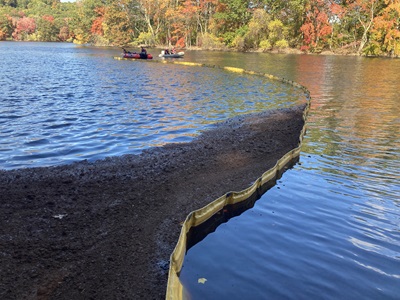Hazardous Materials Emergency Response Plan
Since the construction of the Stony Brook and Hobbs Brook Reservoirs in the late 1800s, major growth in the region’s transportation network and changes in land use patterns have brought significant development and highway infrastructure to the area surrounding both reservoirs. The Cambridge Water Department has taken preemptive steps to facilitate a rapid response to protect the water supply should a hazardous material be released in or near it. Furthermore, since the reservoirs are located outside the City of Cambridge, there is a need to involve the four communities in the watershed - Lexington, Lincoln, Waltham, and Weston - as well as several key state agencies to ensure fast response in the event of an emergency.
Under the 2003 Emergency Response Plan and 2006, 2014, and 2019 updates, the Cambridge Water Department has identified the following stages in emergency management that help reduce overall risk to the water supply.
1. Mitigation
Common mitigation measures used throughout the watershed are zoning and land use controls, barrier construction, and best management practices (BMPs) to minimize the access of hazardous materials to the Cambridge Water Supply. MassDOT has begun diverting highway runoff away from reservoirs into stormwater management basins and constructed wetlands that allow particulates to settle out of stormwater and allow more time for First Responders to clean up spills in the event of an emergency.
2. Preparedness
Hazardous materials response equipment is available to responders at six locations in the upper watershed. The Waltham Fire Department, which would be the first responder for most of the area around the two reservoirs, is trained and drilled on the use of the equipment. In addition, a Hazmat Atlas showing all highway outfalls, stormwater/spill retention basins and equipment storage locations has been developed and distributed to all watershed First Responders. This atlas is updated on a regular basis to reflect additions or changes to the local drainage infrastructure.

The Waltham Fire Department practices containment-boom deployment in Hobbs Brook Reservoir using peat moss to simulate a spill.
3. Response
In the event of a hazardous material introduction into the watershed, first responders immediately take action to contain and remove hazardous materials from the watershed. After the materials have been contained, assessment of the environmental impact and remediation, if needed, will be conducted to ensure a safe raw (untreated) water supply.
4. Recovery
In the event of a hazardous materials emergency, safe drinking water will be supplied to Cambridge residents from the unaffected source waters or from a Massachusetts Water Resources Authority (MWRA)-supplied emergency water main. Hazardous materials releases will be cleaned to restore watershed health and to secure the viability of this water source for future use.